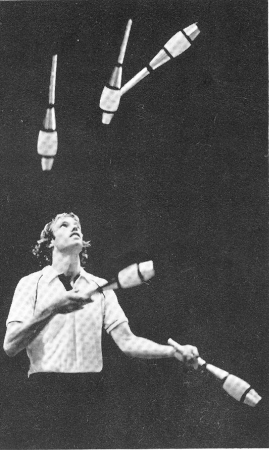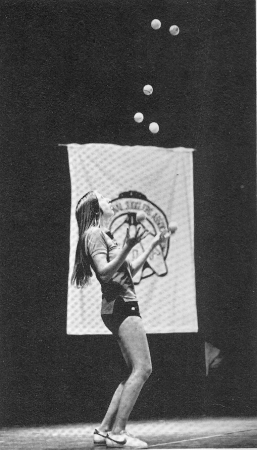Franco
said, "'I was trying to do ridiculous things in my act, four
and five ping pong balls, nine rings and seven balls. Then Bobby
helped me tone down the numbers and put my most commercially viable
and solid tricks together into an act. "
Franco
can do nine rings, and works up from three to seven without stopping
in his act, but thinks nine or ten is a totally impractical trick
for the nightclub circuit. "I haven't performed in a place
yet that has a ceiling high enough to do nine," he said.
Michael
Kass, the IJA's 1980 Fargo Convention Seniors champion, agrees with
Franco. "Numbers aren't worthwhile," the Princeton
University senior said. "In the time it takes to get good with
seven objects, you can learn just about everything there is to know
about, say... cigar boxes. You can only perform seven for a couple
of seconds as a finale to your act, while you can work a whole
routine out of cigar boxes or three clubs. I worked on seven balls
long enough to convince myself that it's more worthwhile to
concentrate on other things."
The
long hours it takes to work seriously on numbers may give a
solitary, stationary individual a better chance at a world record
than a performer.
One
interviewee commented, "I'm always impressed to see what can be
accomplished with irrational dedication, and that's what it's going
to take to set any new juggling records."
Not
many of the 17 entrants in last summer's IJA seven object
competition are professional performers, despite their skill with
numbers. As one IJA director observed, "Though it's not
universal, many numbers jugglers seem to be solitary individuals.
"
They
are persistent, repeatedly analyzing what is wrong inside their
patterns and working to correct it on the next try. Ron Graham from
Murray Hill, NJ, notes, "Every throw is a bad throw and it's up
to the other hand to correct it."
Graham,
a hobbyist himself, tried to improve his chances by devising a waist
net to catch drops at an easily retrievable height when he practiced
six and seven objects. It conquered the theorem that balls always go
into the most inaccessible place in the room, but Graham found the
arrangement almost too efficient. "I lost the natural rest
period that comes when you bend over to pick up your drops, and got
tired after a short workout," he explained.
Graham
has dreamed of many ways to try to slow gravity in order to increase
the numbers he can juggle. But turbulence created by his hands
doomed the underwater experiment, balloons turned out to be too
light and balls fitted with parachutes just didn't work.

